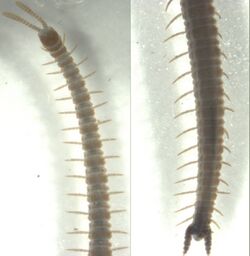Biology:Ballophilus
From HandWiki
Short description: Genus of centipedes
| Ballophilus | |
|---|---|

| |
| Ballophilus hounselli | |
| Scientific classification | |
| Domain: | Eukaryota |
| Kingdom: | Animalia |
| Phylum: | Arthropoda |
| Subphylum: | Myriapoda |
| Class: | Chilopoda |
| Order: | Geophilomorpha |
| Family: | Ballophilidae |
| Genus: | Ballophilus Cook, 1896 |
Ballophilus is the largest genus of centipedes in the clade Ballophilidae.[1] Species in this genus are found in tropical and subtropical regions, mainly in Africa and southeast Asia.[2]
Species
There are about 40 species, including:[3]
- Ballophilus alluaudi
- Ballophilus australiae
- Ballophilus braunsi
- Ballophilus clavicornis
- Ballophilus comastes
- Ballophilus conservatus
- Ballophilus differens
- Ballophilus fijiensis
- Ballophilus filiformis
- Ballophilus flavescens
- Ballophilus foresti
- Ballophilus giganteus
- Ballophilus granulosus
- Ballophilus hounselli
- Ballophilus insperatus
- Ballophilus kraepelini
- Ballophilus latisternus
- Ballophilus lawrencei
- Ballophilus liber
- Ballophilus maculosus
- Ballophilus maldivensis
- Ballophilus mauritianus
- Ballophilus neocaledonicus
- Ballophilus pallidus
- Ballophilus paucipes
- Ballophilus pedadanus
- Ballophilus peruanus
- Ballophilus polypus
- Ballophilus pygmaeus
- Ballophilus ramirezi
- Ballophilus riveroi
- Ballophilus rouxi
- Ballophilus sabesinus
- Ballophilus smaragdus
- Ballophilus taenioformis
- Ballophilus tercrux
Description
Centipedes in this genus range from about 1 cm to about 7 cm in length and have 37 to 91 pairs of legs.[2] The Asian species Ballophilus pallidus measures only 11 mm in length and can have as few as 37 leg pairs (37 or 39 in males, 41 in females), the minimum number found in this genus.[4] Both B. fijiensis and B. giganteus can have as many as 91 leg pairs, the maximum number found in this genus, but B. giganteus is also notable for its large size, reaching 75 mm in length.[5][6]
References
- ↑ Pereira, Luis Alberto; Foddai, Donatella; Minelli, Alessandro (1996-12-01). "First Record of a Ballophilid Centipede from Argentina with a Description of Ballophilus ramirezi n.sp. (Chilopoda: Geophilomorpha: Ballophilidae)". Studies on Neotropical Fauna and Environment 31 (3-4): 170–178. doi:10.1076/snfe.31.3.170.13335. ISSN 0165-0521. https://doi.org/10.1076/snfe.31.3.170.13335.
- ↑ 2.0 2.1 Bonato, Lucio; Edgecombe, Gregory D.; Zapparoli, Marzio (2011). "Chilopoda – Taxonomic overview". in Minelli, Alessandro. The Myriapoda. Volume 1. Leiden: Brill. pp. 363–443. ISBN 978-90-04-18826-6. OCLC 812207443. https://www.worldcat.org/oclc/812207443.
- ↑ "ITIS Standard Report Page: Ballophilus". https://www.itis.gov/servlet/SingleRpt/SingleRpt;jsessionid=93427D719F17A84E51D3FDD923671379?search_topic=TSN&search_value=1093405#null.
- ↑ Attems, C. (1938). "Die von Dr. C. Dawydoff in französisch Indochina gesammelten Myriopoden" (in German). Mémoires du Muséum d'Histoire Naturelle. Paris, N.S. 6 (2): 187-353 [323]. https://www.biodiversitylibrary.org/item/277852#page/139/mode/1up.
- ↑ Chamberlain, Ralph V. (1920). "The Myriopoda of the Australian Region". Bulletin of the Museum of Comparative Zoology at Harvard College 64: 1-269 [37]. https://www.biodiversitylibrary.org/page/30743608#page/13/mode/1up.
- ↑ Demange, J.-M. (1963). "Chilopoda: La Réserve Naturelle Integrale du Mont Nimba" (in French). Mémoires de l'Institut Francaise d'Afrique Noire 66 (5): 41-118 [68].
Wikidata ☰ Q4354220 entry
 |

